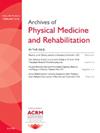Effect of Training in Visual Motor Imagery to Improve Reaching and Gripping Actions for a Single Subject with Stroke in the Supplementary Motor Area 4344
IF 3.6
2区 医学
Q1 REHABILITATION
Archives of physical medicine and rehabilitation
Pub Date : 2025-04-01
DOI:10.1016/j.apmr.2025.01.061
引用次数: 0
Abstract
Objectives
To investigate the effect of my rehabilitation using visual motor imagery training on a subject with stroke in the supplementary motor area. The subject had disorders with reaching and gripping actions, cognitive decline, and attention deficit.
Design
This report is a single case intervention study of before-after trial of my rehabilitation.
Setting
The setting is hospitalized acute phase rehabilitation for a single subject. The study was approved by the local ethics committee and conducted in accordance with the Declaration of Helsinki. The patient gave written, informed consent.
Participants
The study was a 70-year-old subject with stroke on the right side of the supplementary motor area. The disease caused the subject to have a disability in reaching and gripping actions. Also, the subject had symptoms of cognitive decline and attention deficit. The physical finding was Fugl-Meyer Assessment upper extremity on the left side (10/66). The neuropsychologic findings were Raven's Colored Progressive Matrices (20), Token Test (15), Trail Making Test (impossible).
Interventions
The intervention was visual motor imagery training for the subject 1 time a day for 40 minutes per day, 5 days, for a period of 3 weeks. The motor imagery training consisted of 2 steps. Firstly, the subject was shown 3 videos, which showed motor actions of the hand grasping, hand rotation, and reaching and gripping a ball. These videos also showed the therapist's own hand movements. During this process, the subject mentally rehearsed these actions without overt movement. After this, the subject attempted to execute these motor actions physically.
Main Outcome Measures
The subject's upper limb function was evaluated as follows: reaching and gripping action times to a ball which was held at 40 cm in front of the subject (30.31s), reaching and gripping action times to a cup (impossible), and reaching and gripping action times to a bowl (impossible).
Results
These reaching and gripping actions were changed after my rehabilitation period of 3 weeks. The reaching and gripping action times to a ball (5.11s), the reaching and gripping action times to a cup (9.89s), and reaching and gripping action times to a bowl (7.82s).
Conclusions
Visual Motor imagery training had a positive effect on the single subject with supplementary motor area stroke to improve the reaching and gripping actions, although the subject had cognitive decline and attention deficit.
Disclosures
none.
视觉运动意象训练对提高单个中风受试者辅助运动区伸手和抓握动作的影响
目的探讨视觉运动意象训练对脑卒中患者辅助运动区的康复效果。受试者有伸手和抓握动作障碍、认知能力下降和注意力缺陷。本报告是对本人康复前后试验的单例干预研究。研究背景:单个受试者住院急性期康复。该研究得到了当地伦理委员会的批准,并按照《赫尔辛基宣言》进行。病人给出了书面的知情同意。研究对象是一位70岁的老人,右侧辅助运动区中风。该疾病导致受试者在伸手和抓握动作方面有残疾。此外,受试者有认知能力下降和注意力缺陷的症状。物理检查结果为左上肢Fugl-Meyer评估(10/66)。神经心理学结果为Raven’s Colored Progressive Matrices (20), Token Test (15), Trail Making Test(不可能)。干预措施:对受试者进行视觉运动意象训练,每天1次,每天40分钟,共5天,为期3周。运动意象训练分为两个步骤。首先,给被试播放3个视频,分别展示了手抓球、手旋转、伸手抓球的运动动作。这些视频还展示了治疗师自己的手部动作。在这个过程中,受试者在没有明显动作的情况下,在心里预演这些动作。在此之后,受试者尝试用身体来执行这些运动动作。主要观察指标:对被试上肢功能进行评估:对被试前方40 cm处的球的伸手和抓握动作时间(30.31s),对杯子的伸手和抓握动作时间(不可能),对碗的伸手和抓握动作时间(不可能)。结果经过3周的康复治疗后,手握动作发生了改变。拿球和抓球的时间(5.11秒),拿杯子和抓球的时间(9.89秒),拿碗和抓球的时间(7.82秒)。结论视觉运动意象训练对辅助性运动区卒中患者的伸手和抓握动作有积极的改善作用,但存在认知能力下降和注意力缺陷。
本文章由计算机程序翻译,如有差异,请以英文原文为准。
求助全文
约1分钟内获得全文
求助全文
来源期刊
CiteScore
6.20
自引率
4.70%
发文量
495
审稿时长
38 days
期刊介绍:
The Archives of Physical Medicine and Rehabilitation publishes original, peer-reviewed research and clinical reports on important trends and developments in physical medicine and rehabilitation and related fields. This international journal brings researchers and clinicians authoritative information on the therapeutic utilization of physical, behavioral and pharmaceutical agents in providing comprehensive care for individuals with chronic illness and disabilities.
Archives began publication in 1920, publishes monthly, and is the official journal of the American Congress of Rehabilitation Medicine. Its papers are cited more often than any other rehabilitation journal.

 求助内容:
求助内容: 应助结果提醒方式:
应助结果提醒方式:


